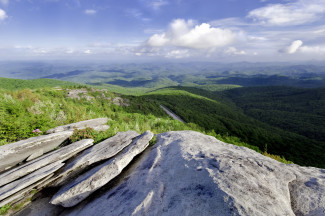
Johns Hopkins UniversityEst. 1876
America’s First Research University
It's About the Regions

Writing a book that is designed to be both a textbook and a reference volume requires a strong bridge between the two objectives. For Across This Land the bridge is regional geography, which is basically an orderly way of keeping track of things geographically. In writing history, the ordering is chronological, with geography in second place among the subheadings. When the purpose is geographical—as here, to cover the broad expanse of the United States and Canada in a single volume—history still determines the ordering even though eons of geologic time and the events of human history both must be accommodated.
For these reasons and more, the book begins with Newfoundland. It is where the sun rises, where the Vikings made landfall, and where the Appalachians first emerged. Newfoundland has these claims to priority, and it was an easy choice to be the first chapter in Across This Land. But Newfoundland is only vaguely known to most people, which makes it seem like an odd place to start. A friend who read the first few chapters when I began writing the book asked, "are all of the chapters going to have so much detail?" The same question was in the back of my mind. But delving into the details of isolated Newfoundland and Labrador is a good way to begin learning about what makes a region.
Regions are malleable constructs that can be stretched and subdivided almost without limit. They also can be thought-provoking. A manuscript reviewer commented on the decision to place New York and Ontario in a single chapter. Apart from bordering on Lake Ontario, what do they have in common? For one, this very circumstance meant that they straddled the entryways Europeans first made into North America. New York and Ontario contain the largest cities in their respective countries and must have shared some kind of common history of growth, yet the two are so different it is jarring to consider them together. (One might add that there is also a cartographic benefit. Because New York and Ontario fit so comfortably together, side by side, their shared map neatly fills a page.)

The US Midwest is broken into two regions, one with Corn Belt agriculture as its theme, the other with Great Lakes industry as the focus. The two regions overlap substantially, of course, which shows that regions need not be discrete nor do their borders need to be sharp. Chicago's history ties it closely to the Corn Belt, while the histories of Cleveland, Detroit, and Milwaukee are more about industrial production. Yet all of the cities, farms, and industries are also part of a single region, the one that many consider as most typically American, the Midwest.
One might wonder why it is necessary to have a short chapter devoted just to the Ozark and Ouachita mountains. Could not this isolated, sparsely populated section of Missouri, Arkansas, and Oklahoma be attached to something adjacent? The answer is that there simply isn't any adjacent territory that shares much in common with the Ozark and Ouachita mountains. The impulse to attach it to some bigger region is understandable, but geography wins. The region exists, on its own terms.
Across This Land moves from East to West, first via the South, through the Midwest, and then to the mountains and deserts. The book finishes with a broad sweep across the frozen North and then follows down the Pacific Coast and ends in Hawaii. No logic dictates this meandering sequence that crosses the US-Canadian border at least half a dozen times. Although this border is one of the world's friendliest, most permeable, and most frequently crossed, the very act of crossing is a reminder that countries are not malleable like regions. Keeping differences in mind also is a good way to appreciate similarities.
Order Across This Land: A Regional Geography of the United States and Canada – published on February 11, 2020 – at this link: https://jhupbooks.press.jhu.edu/title/across-land
John C. Hudson is a professor of geography and the director of the Program in Geography at Northwestern University. He is the author of Across This Land: A Regional Geography of the United States and Canada, and coauthor of American Farms, American Food: A Geography of Agriculture and Food Production in the United States.



